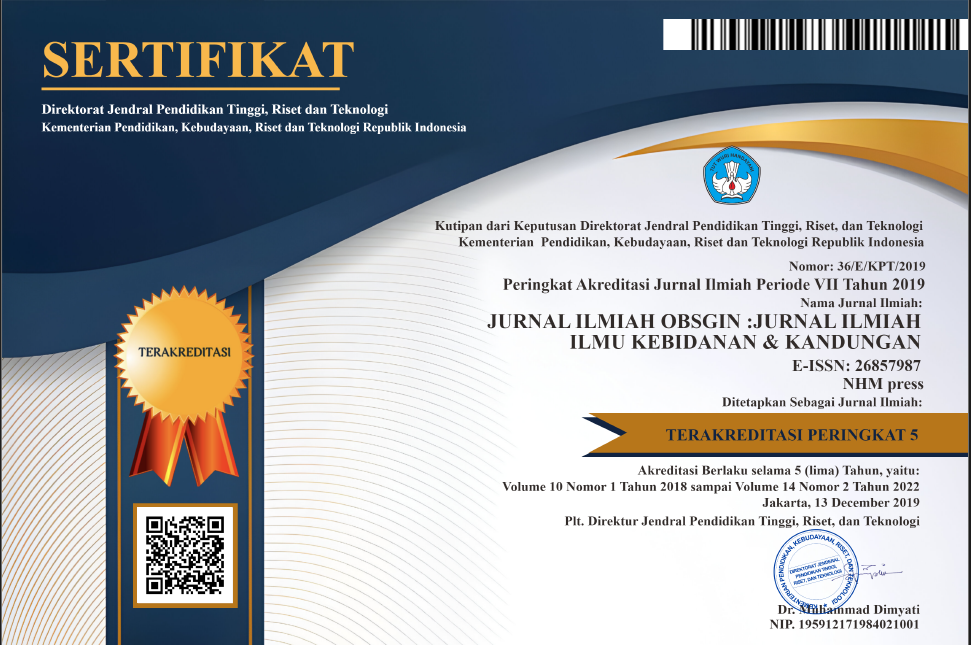RIWAYAT ANEMIA PADA KEHAMILAN SEBAGAI PREDIKTOR KEJADIAN STUNTING PADA ANAK: LITERATUR REVIEW
Abstract
Anemia of pregnancy is a very large public health problem in the world, especially for women of reproductive age (WUS). Anemia of pregnancy is very risky for the baby to be born and will cause stunting in toddlers. This is because the nutritional intake obtained is not sufficient. The purpose of this study was to determine the relationship between a history of anemia in pregnancy and the incidence of stunting in children. Not all anemia of pregnancy can cause stunting in children, but it is better based on the results of this article review where there are articles that state that there is a relationship between a history of anemia and the incidence of stunting, it is hoped that mothers can prevent anemia during pregnancy. The results of this article review can be used as reference material for parties in improving services by preventing stunting in children
References
Alifariki, L. O. (2020). Gizi Anak dan Stunting. Yogyakarta. Penerbit LeutikaPrio.
Astuti, A., Muyassaroh, Y., & Ani, M. (2020). The Relationship Between Mother’s Pregnancy History and Baby’s Birth to the incidence of stunting in infants. Journal of Midwifery Science: Basic and Applied Research, 2(1), 22–26.
Biswas, J., Banerjee, K., Sanyal, P., Datta, M., Choudhury, S., Dasgupta, S., Gupta, S. Sen, & NATH, D. E. Y. A. (2015). Fetomaternal Outcome of Pyrexia in Pregnancy: A Prospective Study.
De Onis, M., & Branca, F. (2016). Childhood stunting: a global perspective. Maternal & Child Nutrition, 12, 12–26.
Drury, S. S., Scaramella, L., & Zeanah, C. H. (2016). The neurobiological impact of postpartum maternal depression: prevention and intervention approaches. Child and Adolescent Psychiatric Clinics, 25(2), 179–200.
Grober, U. (2012). Mikronutrien: Penyelarasan Metabolik, Pencegahan, dan Terapi. Jakarta: EGC.
Jihad, J. (2016). Analisis Determinan Kejadian Stunting pada Balita Usia 12-24 Bulan di Wilayah Kerja Puskesmas Puuwatu Kota Kendari Tahun 2016. (Jurnal Ilmiah Mahasiswa Kesehatan Masyarakat), 1(3).
Kemenkes RI. (2018). Hasil utama RISKESDAS 2018. In Kementerian Kesehatan Badan Penelitian dan Pengembangan Kesehatan. https://kesmas.kemkes.go.id/assets/upload/dir_519d41d8cd98f00/files/Hasil-riskesdas-2018_1274.pdf
Leki, R. E. (2019). Risiko Anemia Kurang Energi Kronis Saat Hamil Dan Penambahan Berat Badan Ibu Selama Hamil Yang Tidak Sesuai Standar IOM Terhadap Kejadian Stunting Pada Balita Usia 24-59 Bulan Di Kecamatan Lamaknen Selatan. Jurnal Penelitian Dan Kajian Ilmiah Kesehatan Politeknik Medica Farma Husada Mataram, 5(2), 141–152.
Nurdin, S. S. I., & Katili, D. N. O. (2019). Faktor Risiko Balita Pendek (Stunting) di Kabupaten Gorontalo. JURNAL ANTARA KEBIDANAN, 2(4), 50–60.
Organization, W. H. (2014). Global nutrition targets 2025: Stunting policy brief. World Health Organization.
Rangki, Alifariki L.O, H., Rahmawati, R., & Sukurni, Salma, W. . (2020). Risk Factors of Stunting in Children Age 24-59 Months Old. Media Keperawatan Indonesia, 3(1), 10–16.
Righetti-Veltema, M., Bousquet, A., & Manzano, J. (2003). Impact of postpartum depressive symptoms on mother and her 18-month-old infant. European Child & Adolescent Psychiatry, 12(2), 75–83.
Schneider, E. B. (2018). Stunting: past, present, future.
Titaley, C. R., Ariawan, I., Hapsari, D., Muasyaroh, A., & Dibley, M. J. (2019). Determinants of the stunting of children under two years old in Indonesia: a multilevel analysis of the 2013 Indonesia Basic Health Survey. Nutrients, 11(5), 1106.
Tupriliany Danefi, S. S. T. (2020). Literatur Review Anemia dan Kurang Energi Kronik (KEK) Pada Ibu Hamil Sebagai Salah Satu Faktor Penyebab Stunting Pada Bayi Balita. JURNAL SEMINAR NASIONAL, 2(01), 54–62.
Warsini, K. T., Hadi, H., & Nurdiati, D. S. (2016). Riwayat KEK dan anemia pada ibu hamil tidak berhubungan dengan kejadian stunting pada anak usia 6-23 bulan di Kecamatan Sedayu, Bantul, Yogyakarta. Jurnal Gizi Dan Dietetik Indonesia (Indonesian Journal of Nutrition and Dietetics), 4(1), 29–40.
Wemakor, A., & Iddrisu, H. (2018). Maternal depression does not affect complementary feeding indicators or stunting status of young children (6–23 months) in Northern Ghana. BMC Research Notes, 11(1), 1–6.
Widiastity, W., & Harleli, H. (2021). Hubungan Pemberian MP-ASI Terhadap Kejadian Stunting Pada Balita Usia 6–24 Bulan di Puskesmas Soropia. Nursing Care and Health Technology Journal (NCHAT), 1(2), 81–86.
Widyaningrum, D. A., & Romadhoni, D. A. (2018). Riwayat anemia kehamilan dengan kejadian stunting pada balita di Desa Ketandan Dagangan Madiun. Medica Majapahit (JURNAL ILMIAH KESEHATAN SEKOLAH TINGGI ILMU KESEHATAN MAJAPAHIT), 10(2).
World, & Organization. (2010). Nutrition landscape information system (NLIS) country profile indicators: Interpretation guide. World Health Organization.











